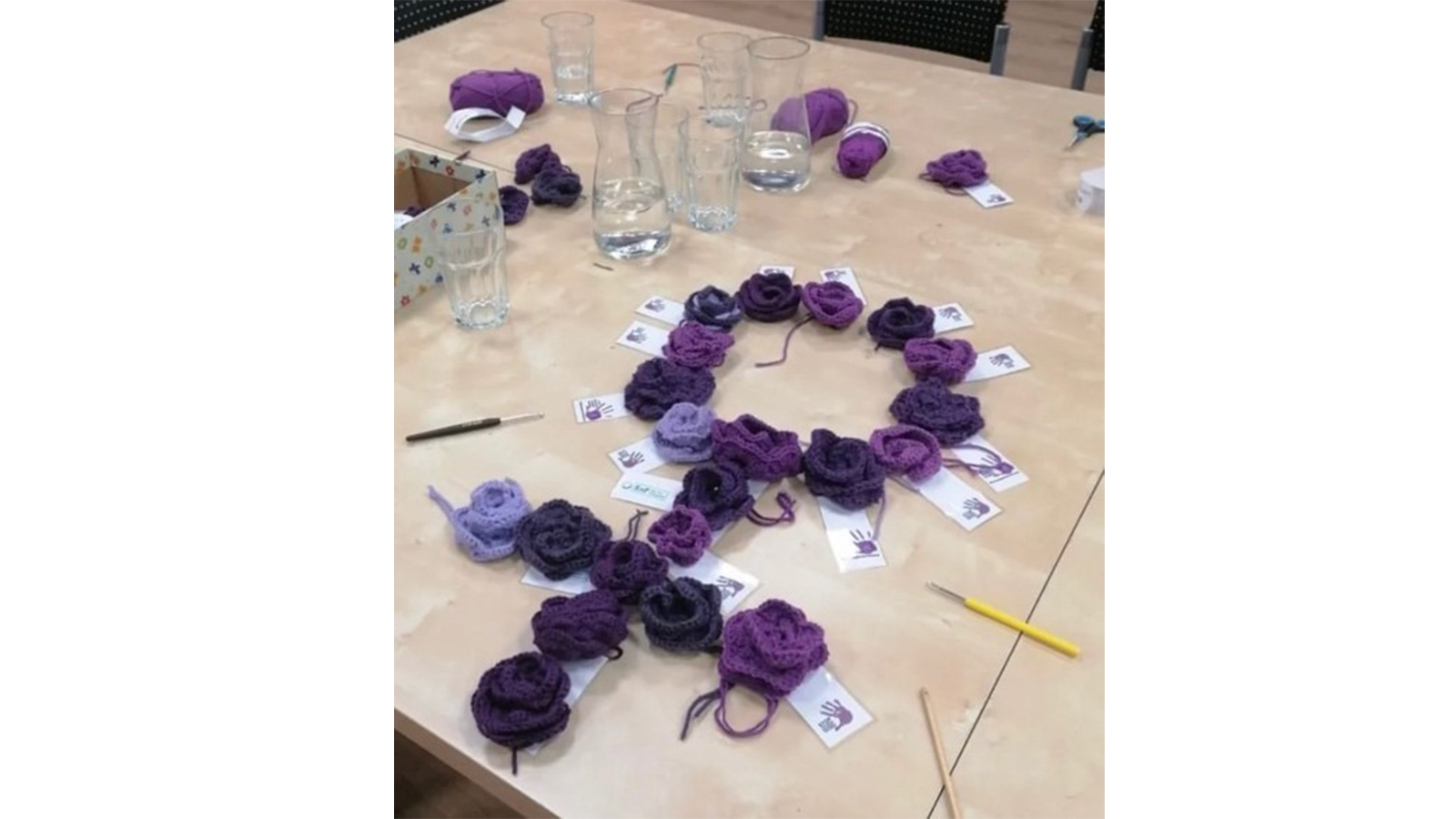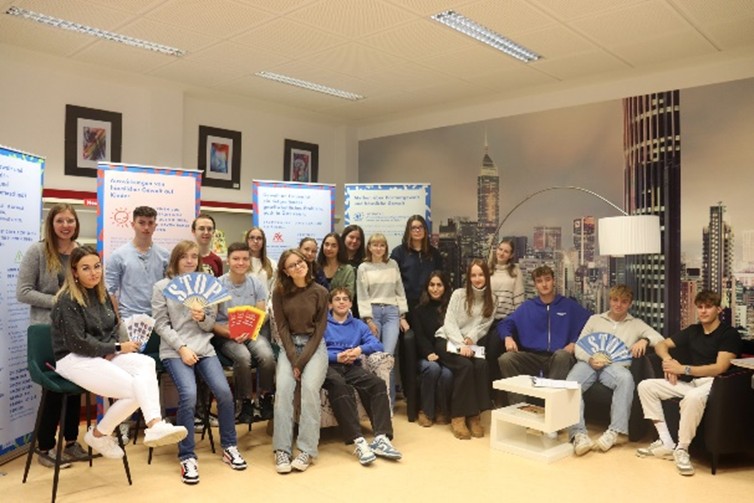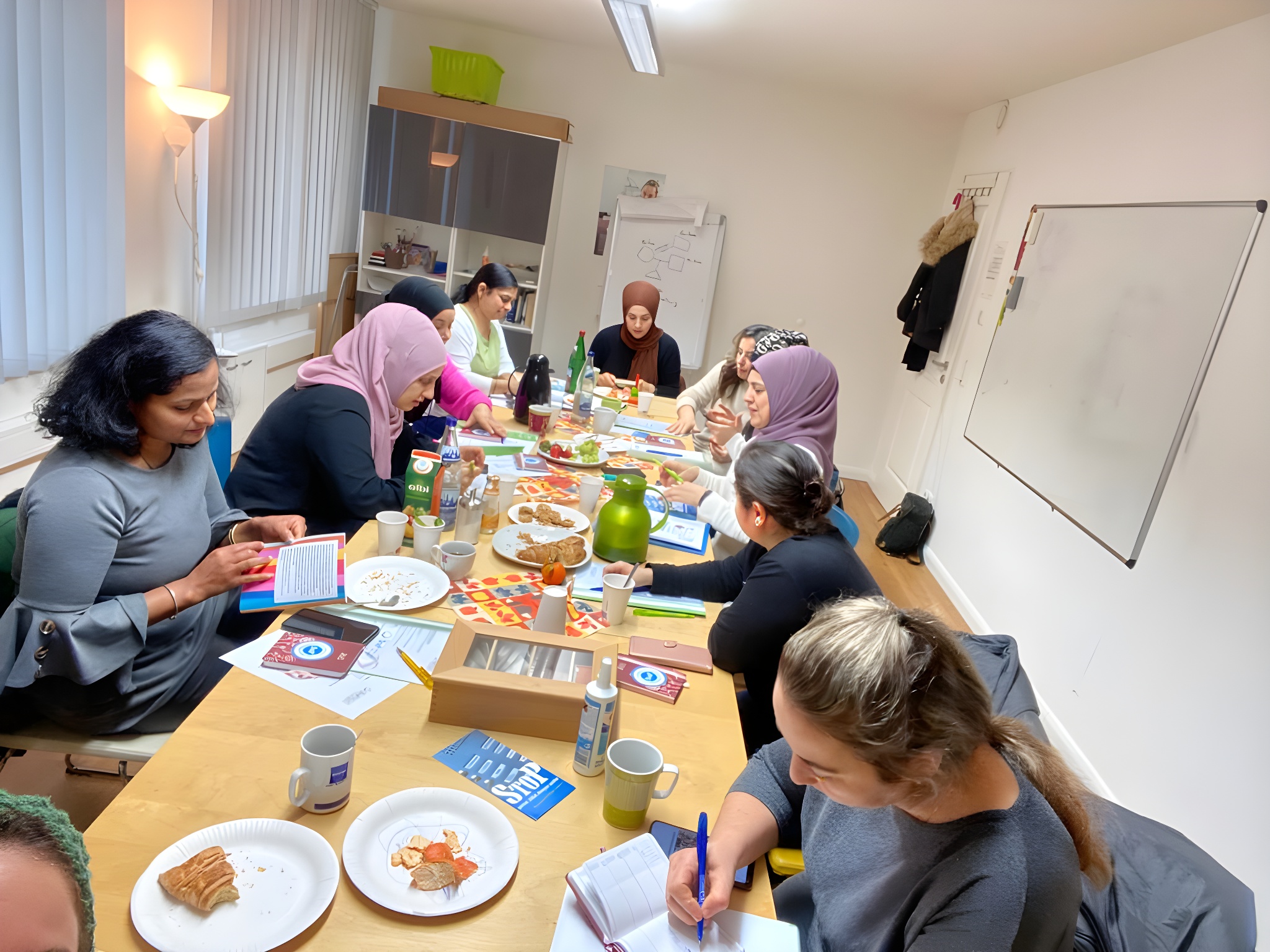Why
Sustainable social change is needed to stop massive violence against women*. It will not happen without widespread changes in attitudes and behaviour and the support of many people. This requires information and knowledge as well as ideas for action and organised collective action. In community organising, action research through door-knocking is a key method for promoting this. It can play a role in steps 2, 3 and 4 (community assessment, organisation, action).
What
A door-knocking survey is not representative, but it is meaningful. It is not external to a change process, but part of it. It is more about conversations than interviews, the respondent is approached as a potential ally, a citizen and neighbour with knowledge, skills and ideas. Action research by door-knocking is not a classic research method, where academics from outside the neighbourhood come (once), ask questions or make observations, and then evaluate and use them in the context of their academic subjects and careers. It belongs in the context of action research, which can be traced back to the social psychologist Kurt Lewin. According to Lewin, the aim of action research is to start from concrete problems and to promote direct social action to solve them. For “research that produces nothing but books is of no use to the individual” (Lewin 1948, p. 280). In other words: Action research is an approach to research that aims both to take action and to generate knowledge or theory about that action as it unfolds. It begins with everyday experience and is concerned with the development of living knowledge (Coghlin 2022). One of its characteristics is that the role of respondents and observers changes from passive objects to active subjects, including participation in the design and conduct of interviews, as well as involvement in evaluation and subsequent action, this is why nowadays the term participatory action research is commonly used.
“Participatory action research (PAR) involves the participation and leadership of people experiencing problems who take action to create emancipatory social change by conducting systematic research to generate new knowledge.”
Objectives
For local organisers
- Gather information (impression of the neighbourhood, prevalence of violence, understanding of violence, importance of the issue for the conversation partner, suggestions for action)
- Use the questions to stimulate reflection and positioning on partner violence
- Raise awareness of StoP and help remove the taboo surrounding domestic violence
- Mobilising (people express ideas for action, agree to pass on flyers, come to the evaluation meeting for this survey, attend StoP events...)
- Find allies
For interviewers / members of StoP
- Place the Stop work firmly in the hands of the residents, so action research becomes truly participatory
- Expand the resources of those already active through training and implementation: self-confidence, conversation skills, knowledge about and contacts in the district
- practice public speaking
Facilitators guide
The organiser needs to be trained in this method. Learning how to conduct a door-knocking conversation is part of the StoP training that all professional StoP workers undergo. In terms of attitude, a 'research-based curiosity', an interest in other people, a certain amount of trust in them, some courage and the ability to approach others in an appreciative and open way are fundamental, as well as enjoying the conversation and being able to adapt to other people and settings. This is also reflected in the use of open questions, even if the topic of the survey is confined to domestic violence against women as in the case of StoP. Based on the relevant literature (Lüttringhaus/Richers 2003), we developed the ‘StoP action research questionnaire’ (see ‘downloads’).
The StoP organiser passes on his or her knowledge to the active citizens in the community groups. They practise in depth the door-knocking conversation with those from the Stop network who wish to participate, so that confidence develops and there is no need to read out the questions, but a more relaxed and as normal as possible discussion situation can develop. Expectations (e.g. how many interviews, where?) as well as concerns should be discussed and reservations clarified. For example, one trainee said: 'I wouldn't open the door to anyone myself, it looks like a Jehovah's Witness or a fund-raiser'. Or there is anxiety about who and what to expect when the front door opens. Here it is helpful to practise role-playing and to create guidelines, e.g. by talking about warning signs and criteria for breaking off a conversation, e.g. if a neighbour only opens the door in his underwear, if I am afraid of dogs and the person I am talking to does not keep their dog on a leash, if I am met with aggression. Guidelines for training and preparation are provided further down. However, barriers and sensitivities vary from person to person. Some things only become apparent in practice.
Time and people needed
The timing and duration of interviews depend on the area size and number of participants. Ideally, aim for 3–5% of the population, or 540–900 conversations from 18,000 residents. Interviews should last 15–30 minutes, with an average of 20 minutes. For 700 conversations, this totals about 234 hours, or 29 full 8-hour workdays. Since interviews will be conducted by the full-time organizer, trained members of StoP community groups, and other network members, the time will be distributed among several people. The more interviewers and conversations, the better, but interviewers must be well-trained in the approach.
Target groups
All people who live and work in the district, mainly young people and adults, as they are also addressed as potential activists.
Steps / Action
1: Drafting the Door-Knocking Survey
- Collaborate with Network Partners: Discuss the initiative thoroughly with the StoP group and clarify available resources, such as time for participation, venue for the final event, and materials (flyers, questionnaires, clipboards, neighborhood maps).
- Research Population Structure: Understand the demographic composition to ensure the survey reflects the community’s diversity. Avoid surveying only one group, such as elderly people, if others like youth or immigrants are also important.
- Define the Survey Area: Clearly determine the boundaries of the area to be surveyed.
2: Preliminary Survey, Analysis, and Evaluation
- Test the Survey: Conduct a trial run to assess how questions are received, identify interviewer uncertainties, and determine if multilingual interviewers are needed.
3: Evaluation and Adjustments After Initial Survey
- Refine the Area Layout: Based on feedback, adjust the survey area if it is too large or if official boundaries do not align with residents’ perceptions of their neighborhood.
- Define Evaluation Criteria: Set clear criteria to assess whether the area and survey goals are appropriate, ensuring the survey is effective and relevant.
4: Training and Preparation of Interviewers
- Prepare Interviewers: Train interviewers in survey techniques, focusing on their ability to engage with diverse residents. Role-playing is recommended to build confidence.
- Ensure Language Skills: Interviewers should be able to converse in multiple languages to cater to various groups.
- Pair Interviewers: Interviewers should work in pairs to improve efficiency and safety. Ensure they communicate beforehand and exchange contact details.
- Plan the Survey Route: Identify key areas for interviews, such as specific houses, public spaces, or parks.
- Set Interview Targets: Establish goals for the number of doors to knock on and interviews to conduct during each survey round.
- Build Relationships: Use the survey to form personal connections that will support future StoP activities. External interviewers should not be used, as local connections are essential.
- Prepare for Challenges: Discuss potential issues and how to handle them before starting the survey.
4: Training and Preparation of Interviewers
- Prepare Interviewers: Train interviewers in survey techniques, focusing on their ability to engage with diverse residents. Role-playing is recommended to build confidence.
- Ensure Language Skills: Interviewers should be able to converse in multiple languages to cater to various groups.
- Pair Interviewers: Interviewers should work in pairs to improve efficiency and safety. Ensure they communicate beforehand and exchange contact details.
- Plan the Survey Route: Identify key areas for interviews, such as specific houses, public spaces, or parks.
- Set Interview Targets: Establish goals for the number of doors to knock on and interviews to conduct during each survey round.
- Build Relationships: Use the survey to form personal connections that will support future StoP activities. External interviewers should not be used, as local connections are essential.
- Prepare for Challenges: Discuss potential issues and how to handle them before starting the survey.
5: Main Survey
- Pre-Inform Residents: Inform residents in advance via notices or personal letters that an interview will take place.
- Equip Interviewers: Ensure interviewers are well-trained and familiar with the survey guidelines. They should carry identification (e.g., name badge, StoP button).
- Provide Materials: Interviewers should bring informational sheets, StoP materials, and invitations to the evaluation event.
- Manage the Time Frame: Keep the survey duration manageable, so respondents remember the connection to the later community event.
- Handle Sensitive Comments: If discriminatory remarks arise, avoid engaging in lengthy discussions. Instead, ask questions to better understand their perspective before moving on.
- Engage Residents for Future Events: Use the final question to invite residents to a follow-up meeting and gather their contact details for future outreach.
6: Survey Evaluation
- Define Key Terms: Interviewers should agree on key categories and terms before evaluating the responses. These can be refined during analysis.
- Evaluate Quickly: Begin evaluation soon after the survey to capture insights from fresh memories, adding any overlooked details.
7: Community Meeting and Action Groups
- Choose an Accessible Venue: The meeting location should be easy for residents to reach and comfortable for the community.
- Display Evaluation Themes: Use posters summarizing the evaluation themes to encourage participation and foster a sense of ownership among attendees.
- Plan for Media Coverage: Consider how the event will be covered in the media, including social media and local press.
- Avoid Political Overload: Ensure the event is not dominated by politicians or too many professionals, which could overshadow the community's role in solving issues.
For more detailed information, please also see the links below.
Material
StoP door-knocking guideline, notepad, neighbourhood map, pens, stop flyers, giveaways, invitation to the presentation of the door-knocking results (public meeting)
Experiences
We talked to 48 people out of 111 residents (…). The people who had a conversation were all open and very interested, and some of the residents were very well informed. Several residents thanked us for our action and stressed the importance of the project. All 48 people agreed to pass on the folder if needed
She (a neighbour) said that after the conversation she had to think a lot and more and more things came to her.

“Yes, when I think about this work over the last two years... just our house, for example. There are 38... families. Changing, of course. But... it was very anonymous. And then I took my questionaires and went outside. And I thought, Are you ringing? No, you don't really like them. And then I said to myself, No, that's not it. Now ring the bell! So I did. And now ... the first contact. And I'm so speechless with three families... we rejected each other... not just me. The other way round too. And... so much has come out of it that I'm convinced that a) they will definitely pass it on and b) I have a completely different attitude towards these people because they have an opinion that I would never have assumed... or believed. And that's for me... so I can say yes, it's worth it... keep going!”
Links
-
Door-knocking:
-
-
Participatory action research:
-
Networks for action research and learning:
-
References
-
Coghlan, D. (2022). Action research. In V. P. Glăveanu (Ed.), The Palgrave encyclopedia of the possible (pp. 1–12). Palgrave Macmillan. https://doi.org/10.1007/978-3-030-90913-0_180
-
Cornish, F., Breton, N., Moreno-Tabarez, U., et al. (2023). Participatory action research. Nature Reviews Methods Primers, 3(34). https://doi.org/10.1038/s43586-023-00214-1
-
Lewin, K. (1948). Tat-Forschung und Minderheitenprobleme. In G. W. Lewin (Ed.), Die Lösung sozialer Konflikte: Ausgewählte Abhandlungen über Gruppendynamik von Kurt Lewin (pp. 278–298). Christian-Verlag.
-
Lüttringhaus, M., & Richers, H. (2024). Handbuch aktivierende Befragung: Konzepte, Erfahrungen, Tipps für die Praxis (4th ed.). Stiftung Mitarbeit.
-
Sanders, M. K. (1970). The professional radical. New York.
-
University of Kansas.(2004) Community Toolbox. https://ctb.ku.edu/en/table-of-contents/participation/encouraging-involvement/participant-contact/main











